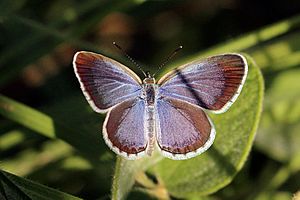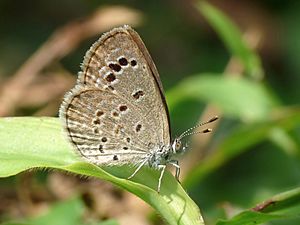Lesser grass blue facts for kids
The lesser grass blue (scientific name: Zizina otis) is a small, pretty butterfly found in many parts of south and southeast Asia. It belongs to the "blue" butterfly family, known for their often bright blue wings. This butterfly was first officially described by Johan Christian Fabricius in 1787. Sometimes, people confuse it with a similar butterfly called the common grass blue (Zizina labradus).
Quick facts for kids Lesser grass blue |
|
|---|---|
 |
|
| Z. o. lampa, upperside | |
 |
|
| Z. o. indica, underside | |
| Scientific classification | |
| Subspecies | |
and possibly two undescribed subspecies from Sulawesi/Selayar & Banggai. |
Contents
What Does the Lesser Grass Blue Look Like?
Male Butterflies
Top Side (Upperside)
Male lesser grass blue butterflies are a pale violet-blue color. In certain light, their wings can look silvery. The front wings have a wide brown edge along the outer part, which is widest at the top (apex). This brown edge can be very wide on some butterflies or much narrower on others.
Under Side (Underside)
The underside of the male's wings is brownish-grey. On the front wings, there's a short, dark, curved line in the middle. There's also a row of seven tiny black spots, each surrounded by white. The two spots at the back are paired. Near the edge of the wing, there are two more rows of dark spots.
On the hindwings, there are four black spots near the base and nine small black spots in a row across the wing. All these spots are circled with white. The markings near the edge of the hindwing are similar to the front wing.
Female Butterflies
Top Side (Upperside)
Female lesser grass blue butterflies are mostly brown. They have a bit of violet-blue color near the base of their wings. On the hindwings, this blue color can sometimes be seen faintly along the inner edge. Both front and hindwings have thin, dark lines along their edges.
Under Side (Underside)
The underside of the female's wings is a bit darker brown than the male's. However, the markings (spots and lines) are exactly the same as on the male's underside.
Other Features
Both male and female butterflies have black antennae with white rings. Their heads, chests (thorax), and bodies (abdomen) are brown. Males might have a little blue color on their chest and body, but females do not. The underside of their bodies is white.
Where Do Lesser Grass Blue Butterflies Live?
The lesser grass blue butterfly is found in many parts of south Asia. In 2008, it was also seen on the Hawaiian island of Oahu.
Different types, or subspecies, of this butterfly live in different places. For example, Zizina otis labradus is found in the North Island and the northern part of the South Island of New Zealand. Another subspecies, Zizina otis oxleyi, lives only in the southern part of the South Island of New Zealand.
What Do Lesser Grass Blue Caterpillars Eat?
The caterpillars of the lesser grass blue butterfly eat many different kinds of plants. They especially like plants from the Leguminosae family, which are also known as the pea or bean family. Some of the plants they eat include:
- Alysicarpus vaginalis
- Desmodium species
- Glycine max (soybean plants)
- Indigofera species
- Mimosa species
Is the Lesser Grass Blue Butterfly Endangered?
No, the lesser grass blue butterfly is not considered to be in danger. In New Zealand, it has been officially classified as "not threatened" under their New Zealand Threat Classification System. This means there are plenty of them around, and their numbers are stable.
Gallery









